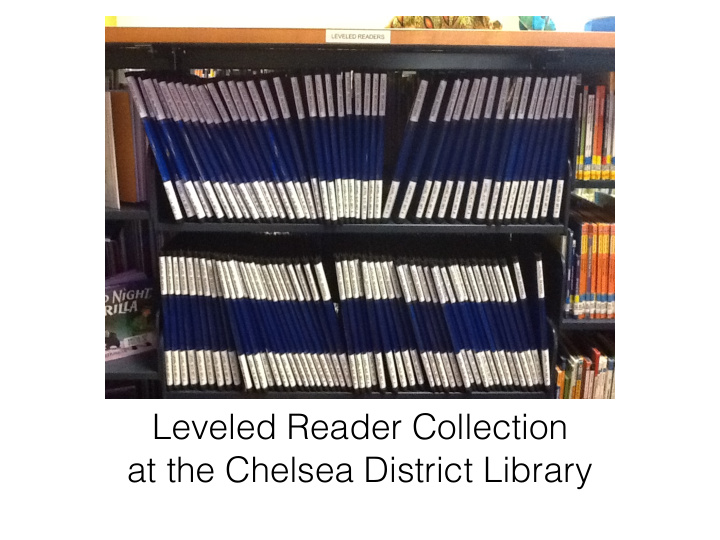



Leveled Reader Collection at the Chelsea District Library
With a generous grant from MIS Cares, the library was able to purchase: • 805 leveled books ranging from beginning kindergarten through mid-second grade. • Protective binders to organize books into "kits". • Laminated mentor instructions for each of the 113 kits. • Individual labels for each book to help introduce the book to your child. • Phonics CD's to help learn letter sounds.
To find the right "level" • Start by asking your child or your child's teacher. • Choose a kit that is a couple levels below that level if possible. The "level" in school is taught by a skilled teacher and often practiced several times. • It's best if your child can be confident, mostly independent, and fairly fluent the first time reading. • If you see your child start to get frustrated, offer to get an easier level or offer more support by reading to them, echo reading, or taking turns. Try to make it a positive experience!
Choosing a kit within a level • Each level has several kits. There are fewer kits in the higher levels, but the books are longer. • Each kit is numbered by "sets" (ex. Level 1/A set 1, Level 1/A set 2, Level 1/A set 3, etc. Level 8/E set 4, Level 8/E set 5, Level 8/E set 6, etc.) • Kits have a variety of books. Book titles are listed on the inside cover of the binder. • Kids don't have to read all the sets in a level before moving to a different level. Moving up or down a level is not going to make a significant difference.
Kindergarten Levels: 1-4 or A-C • Books are repetitive, predictable, easy to memorize, and have lots of picture support • Kits include sight word readers to practice commonly used words in context • Phonics CD's with level 4 kits
Beginning first grade levels: 5-8 or D-E • Mentor instructions review emergent reading skills and concepts about print in kindergarten levels (back side) • Book introductions become more important. Labels on the inside covers or back covers provide a brief description of the book. Also go through each page and discuss pictures and main ideas/ events. • Mix of fiction and nonfiction
Mid to late first grade levels : 9-16 or F-I • Vocabulary is more varied and less "decodable" • Picture support decreases, making it important to work out difficult parts in the introduction. • Mentor guides have reproducible activities. • Rescue Readers are introduced.
"Rescue Readers" Used after level 9 to review and strengthen vowel skills. • 21 titles in three kits. • targeted vowel combination practice with skill practice and stories about rescued dogs and cats. • Detailed activities to review and/or strengthen phonics skills. • Mentor guides from levels 9,10, and 11 refer you to these kits.
Second grade levels: 17-24 or J-L • Fewer books in each kit. • Longer picture books and chapter books • Sets of Reader's Theater books for fluency practice. • Detailed "picture walk" is usually not necessary, but still use the introduction provided. • If fluent reading is not strong, drop back to easier levels. *This is true for all levels.
Try to avoid telling your child to "sound it out" when they get stuck on a word. *making each letter sound individually rarely sounds like a meaningful word. Also, most letters make multiple sounds.
A: apple, cape, again, saw, great, all When telling a child to B: ball, lamb “sound it out” while reading, C: cat, race, cheese, Chris you are asking them to make D: dog, looked, bands E: leg, game, feed, they sounds for the letters in the F: friend, of word they are trying to G: goat, giraffe, laugh figure out. Here are some H: happy, then, enough, hour examples of the many I: middle, dive, rain J: jacket, Jose’ sounds that letters can K: kite, know make. If they only thing you L: bell, walk tell a child is to “sound it N: new, song O: octopus, rope, book, soon, out, do out”, how are they going to P: stop, phone know which sound to make Q: quiet, for each letter? (or when a S: sure, sat, wish, was T: told, thank, this, Thomas letter doesn’t make a U: put, cup, tube, cause sound?) V: vase, have (ex. I have to) W: went, write, saw, down X: X-ray, xylophone Y: yellow, my, baby Z: zoo, pizza
Thank you for coming!
Recommend
More recommend